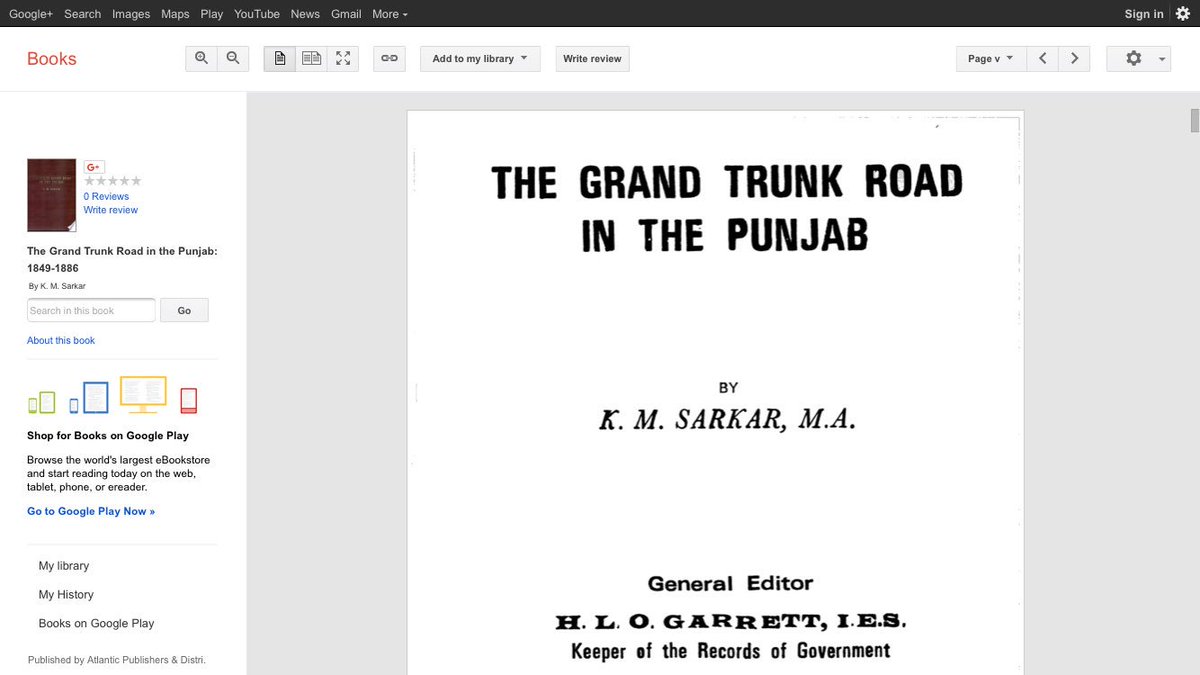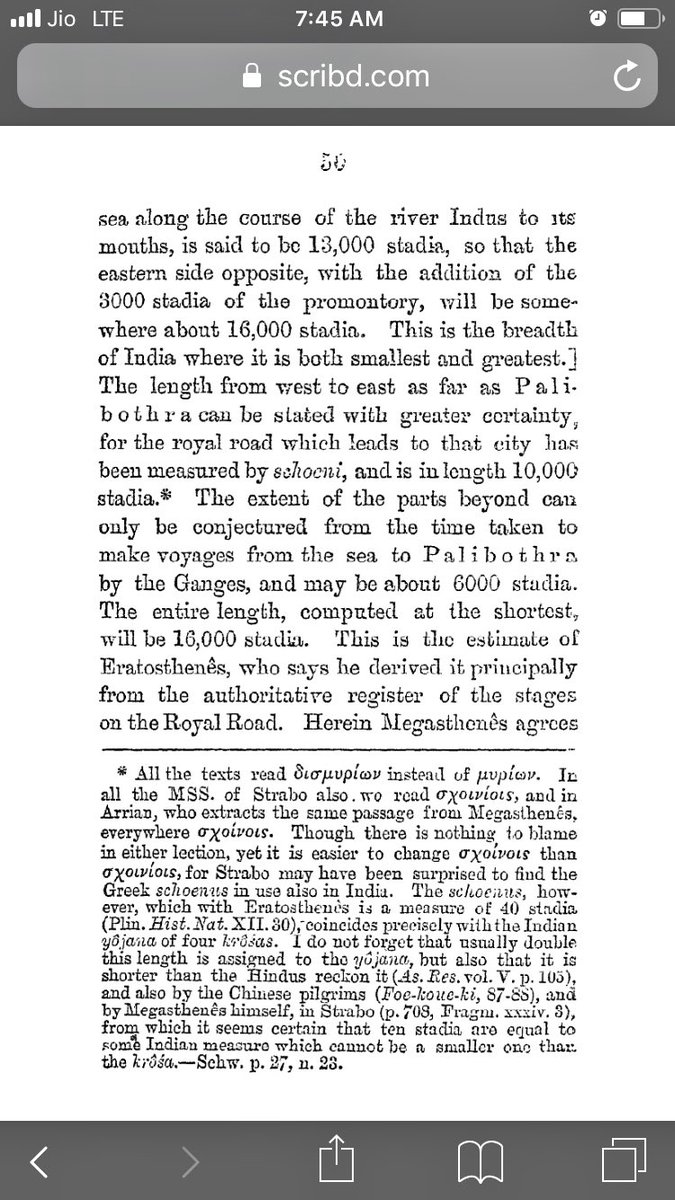1/n Thats bound to happen if academic history begins with ‘Discovery of India’. GT road predates even Buddha& #39;s birth & was called Uttarapatha, meaning: road to the North. In the thread below I explain the Significance & Factual chronicle of the mentioned road. https://twitter.com/sanjivbhatt/status/1000958774616690689">https://twitter.com/sanjivbha...
2/n During the time of the Maurya Empire in the 3rd century BCE, overland trade between India & several parts of Western Asia & the Hellenistic world went through the cities of the north-west, primarily Takshashila. This book maybe referred
3/n Takshashila was well connected by roads with other parts of the Maurya empire. The Mauryas had maintained this very ancient highway from Takshashila to Pataliputra.
4/n Chandragupta Maurya had a whole army of officials overseeing the maintenance of this road as told by the Greek diplomat Megasthenes who spent fifteen years at the Mauryan court. He mentions same in his book Indica. Refer screenshot below:
5/n He talks of a royal road that connects west with Palibothra (Pataliputra) which is 10,000 stadia in length. Definitely GT road existed at least 18 centuries b4 Sher Shah Suri. @PrakashJavdekar these details must be updated in text books.
6/n Constructed in eight stages, this road is said to have connected the cities of Purushapura, Takshashila, Hastinapura, Kanyakubja, Prayag, Pataliputra and Tamralipta, a distance of around 1,600 mi.
7/n Like Uttarapatha we had other imp road: Dakshinapatha. It originated from Sarnath, followed through Ujjaini and Narmada valley to Pratisthana in the Mahajanapada of Ashmaka (in modern Maharashtra), onwards to the western coast of India and running in the southern direction.
8/n Uttarapatha & Dakshinapatha intersected each other at Sarnath, a major place of exchange of goods and ideas in ancient India. No wonder why Buddha gave his first sermon at Sarnath. Or even no wonder to why Deen Dayal Upadhyaya Jn (earlier Mughalsarai) is one of the busiest.
9/n Lets go through few historical records. Panini in his Ashtadhyayi christened it for the first time as Uttarapathenahritam. Uttarapatha is referred to also in the Buddhist literatures like Jataka and Vinaya texts.
10/n The distribution of Ashoka’s rock edicts at junctions of trade routes & in the border areas of the Mauryan Empire demonstrates an extensive system for trans-regional mobility in the middle of the third century BCE.
11/n As per 2nd Major Rock Edict & the 7th Pillar Edict,Ashoka ordered wells excavated and trees planted for both humans & animals along routes, validate facilities for travellers, including his admins,armies ,merchants & Buddhist monks,were provided on this imperial road network
12/n (Refer4/n)This network was also used for military and political expansion by other northern Indian dynasties and by groups of foreign rulers from the Northwest such as the Indo-Greeks, Śakas, and the Kuṣāṇas.
13/n The claim by the eastern Indian ruler Khāravela to have “terrified the kings of the Uttarapatha” in an inscription at Hāthīgumphā (probably belonging to the late first century BCE)indicates that the location of Uttarāpatha was understood in relation to his own domain.
14/n Although the identity of the northern kings is unclear due to the poor condition of the inscription, the glorification of Khāravela’s campaigns against Magadha suggests a geographical location in the middle Ganges.
15/n In epigraphic eulogies of the Chālukyas and their feudatories, Pulakeśin II (died 642 CE) is praised for defeating Harṣavardhana, the “master of all of Uttarapatha” (sakalottarāpatheśvara), presumably meaning the areas north of the Narmada River.
16/n A ninth century inscription found near Nalanda records the life journey of a Buddhist monk named Vīradeva who travelled from the northwest to Buddhist shrines and monasteries in northeastern India.
17/n His birthplace in Nagarāhāra (modern Jalalabad in eastern Afghanistan) is praised as “an ornament to Uttarapatha”. After coming from the Kaniṣka vihāra in modern Peshawar to Bodh Gaya, he was appointed to supervise a monastery in Nalanda.
18/n In this record, Uttarapatha refers to the northwestern heartland of ancient Gandhāra, which remained a major Buddhist cultural centre since monks like Vīradeva continued to travel from there to northeastern India as late as the ninth century.
19/n The term Dakshinapatha is mentioned in the Arthasastra of Kautilya. Buddhist literature also mentions a number of merchants going from Pataliputra and Kaushambi to Pratishthana on the Godavari. The clearest outline of the Dakshinapatha is found in the Suttanipata.
20/n Journeys & campaigns along the Dakshinapatha are mentioned in the Mahabharata & Buddhist literature.The historical imp of the route from Magadha & Kausambi to Pratishthana & Bharukachchha, which basically constitutes the Dakshinapatha is evident from the archaeo sources.
21/n The presence of PGW(Painted Grey Ware) at a number of sites in the Morena and Ujjain districts is indicative of cultural elements travelling from northern India into the Malwa plateau prior to the early historic period.
n/n It seems like an imprudent need to restore history as it was. Our perspective captures only that much forward what it does backwards.

 Read on Twitter
Read on Twitter



